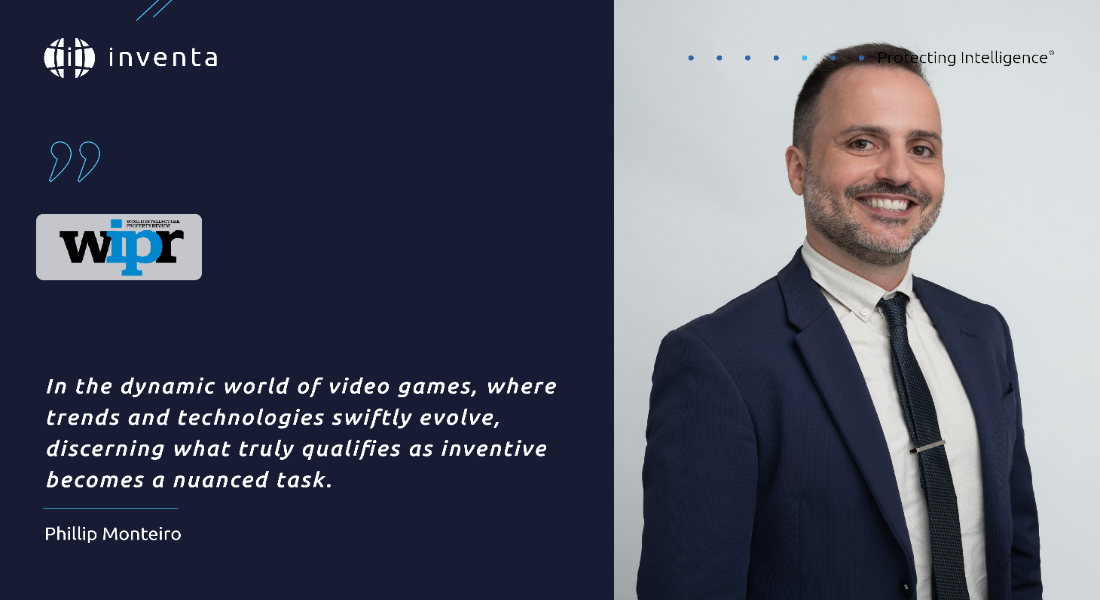OPINIÃO
Protecting video game patents in Europe
The landscape of the video game industry has undergone unprecedented growth in Europe, asserting itself as a dominant force in the entertainment market, with €24.5 billion ($26.8 billion) spent on video games in 2022 and more than 100,000 workers in ten EU markets.
In tandem with this surge, the significance of patent protection for video game innovations has become increasingly apparent. However, safeguarding these patents in Europe is riddled with challenges, primarily stemming from the stringent requirements imposed by the European Patent Office (EPO).
The European patent system: A comprehensive examination
The European patent system, designed to incentivise innovation by granting inventors exclusive rights to their creations, is administered through the EPO. While the system effectively facilitates the protection of various technological advancements, applying its principles to video games introduces intricacies that demand meticulous consideration.
The quest: Technical character and achieving the inventive step
A significant obstacle in obtaining video game patents in Europe lies in satisfying the EPO's requirements of "technical character" and an "inventive step." According to EPO guidelines, an invention must possess a technical character to qualify for patent protection. In the realm of video games, this requirement poses a formidable challenge as games seamlessly intertwine artistic, narrative, and technical elements.
While the underlying software code of a video game unquestionably embodies technical aspects, the narrative, character design, and artistic components may not inherently exhibit the necessary technical character. This raises critical questions about the breadth or narrowness of the EPO's interpretation of the term "technical" in the unique context of video games.
Moreover, establishing an "inventive step" is imperative for patent approval. This necessitates demonstrating that the invention goes beyond being an obvious extension of existing knowledge. In the dynamic world of video games, where trends and technologies swiftly evolve, discerning what truly qualifies as inventive becomes a nuanced task.
The conundrum: Computer programs and software patents in Europe
The EPO's stance on computer programs further complicates the video game patenting process. The EPO explicitly excludes computer programs "as such" from patentability, implying that solely the software component of a video game may not suffice to meet patent criteria - differently from other big patent offices, such as the US Trademark and Patent Office (USPTO), where we can find several software and video games-related patents. Instead, for an EPO Patent Application, inventors must illustrate that the software contributes to a technical solution to a technical problem.
In the case of video games, where software is intrinsic to the overall gaming experience, striking a balance between artistic and entertainment aspects with the technical elements to satisfy the EPO's criteria necessitates a delicate and precise approach.
A dilemma: User interfaces and the challenge of interactivity
An additional layer of complexity in obtaining video game patents lies in the treatment of user interfaces and interactivity. Video games often rely on innovative user interfaces and interactive features to distinguish themselves in the market. However, the EPO requires these elements to transcend mere aesthetics or gameplay enhancements and actively contribute to a technical solution.
Demonstrating the technical nature of user interface innovations and interactive features in video games can be intricate. The EPO's emphasis on tangible technical effects raises questions about how subjective elements such as user experience and engagement align with the rigid requirements of patentability.
An alternative: Protection of industrial designs via EUIPO
Securing protection for user interfaces in video games through industrial designs presents a strategic avenue for developers. Industrial designs serve as a valuable tool to safeguard the unique visual aspects of user interfaces, offering a distinct form of intellectual property protection.
In the dynamic realm of video games, where user experience plays a pivotal role, the visual appeal and functionality of interfaces are crucial. Leveraging industrial designs in the EU allows developers to assert exclusive rights over the ornamental aspects of their interfaces.
Navigating this avenue requires a careful balance between aesthetics and functionality, ensuring that the design not only enhances user interaction but also meets the criteria set forth by EUIPO (not the EPO) regulations for industrial design protection.
Stakeholders: Imperative use of specialised expertise
Given the intricate nature of software and video game patent protection in Europe, navigating the application process demands specialized expertise. Legal professionals with a profound understanding of both the technical and artistic facets of video game development play a pivotal role. They must effectively articulate how the invention extends beyond entertainment value and makes a significant technical contribution.
Collaboration between patent attorneys and video game developers becomes imperative in crafting applications that satisfy the EPO's requirements. This synergy ensures that the intricacies of the game's technology are adequately highlighted, emphasizing the technical character and inventive step necessary for patent approval.
The history: Precedents, case law, and strategic insights
The evolving landscape of video game patents in Europe is further shaped by precedents and case law. Previous decisions by the EPO's Boards of Appeal significantly influence the interpretation of patentability criteria for video games. A thorough analysis of these precedents provides valuable insights into the EPO's expectations, enabling applicants to tailor their strategies in accordance with evolving standards.
Staying well-informed about the latest developments in case law is particularly crucial for video game developers seeking patent protection. This proactive approach allows them to anticipate potential challenges and align their patent applications with the dynamic and evolving standards set by the EPO.
The conclusion: The need to level up some strategic skills
Is feasible to conclude that securing video game patents in Europe proves to be a formidable challenge, given the specific and stringent requirements imposed by the European Patent Office. The delicate balance between artistic creativity and technical innovation inherent in video games demands a nuanced and strategic approach to meet the rigid criteria for patentability.
As the video game industry continues to push the boundaries of technology and entertainment, the collaboration between legal experts and developers becomes paramount. A comprehensive understanding of the technical intricacies, coupled with strategic alignment with EPO requirements, is essential for overcoming the hurdles and securing robust patent protection for video game innovations in Europe.
This is a co-published article, which was originally published in the World Intellectual Property Review (WIPR).
Saiba mais



